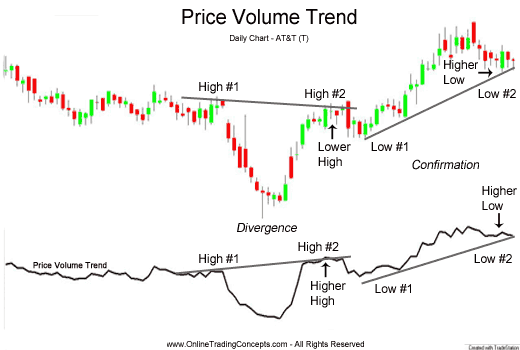Price Volume Trend combines percentage price change and volume to confirm the strength of price trends or through divergences, warn of weak price moves. Unlike other price-volume indicators, the Price Volume Trend takes into consideration the percentage increase or decrease in price, rather than just simply adding or subtracting volume based on whether the current price is higher than the previous day's price. How the formula is calculated is presented below:
- On an up day, the volume is multiplied by the percentage price increase between the current close and the previous time-period's close. This value is then added to the previous day's Price Volume Trend value.
- On a down day, the volume is multiplied by the percentage price decrease between the current close and the previous time-period's close. This value is then added to the previous day's Price Volume Trend value.
The Price Volume Trend is helpful in seeing divergences; examples of these divergences are shown below in the chart of AT&T (T):

The Price Volume Trend indicator is usually interpreted as follows:
- Increasing price accompanied by an increasing Price Volume Trend value, confirms the price trend upward.
- Decreasing price accompanied by a decreasing Price Volume Trend value, confirms the price trend downward.
- Increasing price accompanied by a decreasing or neutral Price Volume Trend value is a divergence and is indicating that the price movement upward is weak and lacking conviction.
- Decreasing price accompanied by a increasing or neutral Price Volume Trend value is a divergence and is indicating that the price movement downward is weak and lacking conviction.
AT&T stock made lower highs, but the Price Volume Trend indicator made higher highs. This bullish divergence warned that bulls might be taking control of the stock and shorting AT&T would not be advisable.
Since the Price Volume Trend indicator multiplies positive volume when prices close higher than the previous day's close, the Price Volume Trend indicator could be interpreted as meaning that more volume flowed into High #2 than flowed into High #1. More volume interest by buyers at High #2 signaled that the price move higher had significant strength behind it and it probably was going to continue.
Low #1 to Low #2The stock price made higher lows, generally considered a bullish signal; the Price Volume Trend indicator confirmed this move higher when it made higher highs as well.
Price Volume Trend is a valuable technical analysis tool that combines both price and volume to confirm price action or warn of potential weakness or lack of conviction by buyers and sellers.- Free trading apps
- Over 8,000 signals for copying
- Economic news for exploring financial markets
You agree to website policy and terms of use
Price and Volume Trend (PVT):
Price and Volume Trend (PVT) indicator, like On Balance Volume (OBV), represents the cumulative sum of trade volumes calculated considering close price changes.
The calculation algorithm is close to that of the indicator OBV. But in OBV we add the whole daily volume to the current indicator value when close prices are higher, and detract the whole volume when close prices are lower, while in PVT we add or detract just a part of daily volume. The exact part of the volume to be added to PVT is determined by the value of price change relatively to the close price of the previous day.
In OBV, the cumulative total volumes for each period are summed. However, in PVT, the volume is multiplied by the coefficient that depends on the difference between the current close price and the previous one.
Author: MetaQuotes Software Corp.